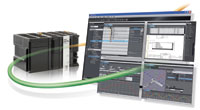
Posted to News on 26th Oct 2011, 00:00
A single automation platform for the entire machine or cell
With its new Sysmac automation platform, Omron offers fast and accurate controllers, one machine network for the entire machine, and a completely integrated software package. Mark Simms reports.

Don't be deceived by the ubiquitous black box exterior. This is not simply another Omron PLC. In fact, not only is the controller itself something quite different from than anything that's come before, it also forms part of a complete automation platform. What does Omron mean by that? It means a complete family of automation products encompassing the machine controller, servos, inverters, vision, I/O modules and more, all communicating on a single, open, high performance network, and all programmed from within a single software package that includes configuration, simulation and monitoring. The goal is to bring you the highest possible performance, while accelerating your development time and helping to reduce or eliminate any programming errors.
That's quite a promise, so the question is: does it deliver? These days everyone talks about integration, but what that really has to mean for the machine builder is the ability to develop high performance systems more quickly, without mistakes, confident that the finished system will work as it was intended. So it's easy to say, but not so straightforward to achieve.
So let's start at the beginning with the controller that's at the heart of the platform. In what Omron describes as 'a bold step into the world of PC automation while retaining the legendary reliability and robustness of an Omron industrial controller', the company has shifted away from a rigid ASIC based architecture and moved instead to a scalable software-centric one, based on the Intel Atom microprocessor. Omron says this delivers considerable functional benefits for today's controller, but will also mean that it can develop the platform more quickly, bringing in new features much faster. For today, the NJ5 controller employs a 1.6GHz Intel Atom processor running a real time operating system, delivering ultra high speed operation performance. The new soft-PLC logic core is 100% Omron's own technology, assuring reliable, accurate, deterministic control.
Motion control technology
Omron has also developed a new general purpose motion core, providing tightly integrated motion control technology. In conventional PLC systems, the logic and motion engines are separate CPUs. But in the NJ5, it's an integrated environment in the same hardware, so you get full synchronisation of motion and PLC functionality within the same task. That is one of the keys for Omron to be able to assure the reliability and predictability of the system.
Let's not forget, though, that this is a complete platform, so there's also tight integration with external servos, inverters, I/O modules and vision systems within the Sysmac range - a range that Omron will now quickly grow. All these are networked over EtherCAT, which Omron has chosen as it's default network technology. In selecting EtherCAT, Omron assessed all the networking options and did extensive testing. It found EtherCAT to provide the best match for its needs.
Perhaps the biggest benefit or machine builders, though, is the ability to configure, program, simulate and monitor the controller and all of the connected Sysmac products from within a single software package. Developed by Omron's software team in Southampton, Sysmac Studio is a totally new platform, built from the ground up. The result is that there is only one environment you need to work in, and only one piece of software you need to learn. Sysmac Studio also helps to eliminate errors, because while you're programming, the software is continually compiling in the background. It can thus flag up any errors you make, as you make them, so there is no complex debugging afterwards. There are also lots of help strings that tell you not just that you've made an error, but why it's an error. So there's no need to be constantly referring to manuals or reference guides.
Omron describes the introduction of the Sysmac platform as a major milestone in its ten year plan aimed at strengthening its position in the machine control market. Undoubtedly there is more to come.









